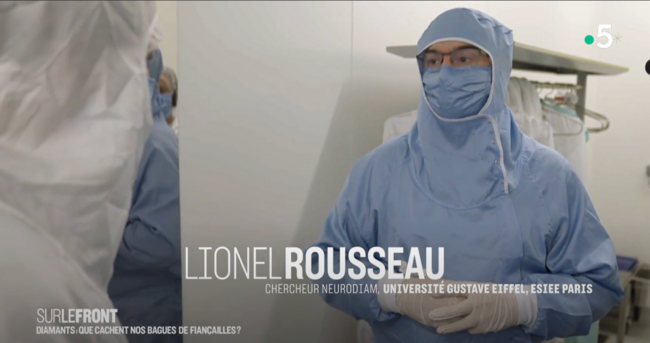News | Research
Diamond implants - ESIEE Paris cleanrooms in the spotlight on France 5
Lionel Rousseau, researcher at ESIEE Paris, is experimenting with using diamonds to restore eyesight.

France 5's programme "Sur le front" featured a report on diamonds on the 18th of December. Lionel Rousseau, researcher and head of cleanrooms at ESIEE Paris, was interviewed about his ERC research project, NEURODiam, which aims to develop an all-diamond implant for neural applications.
What if diamonds could repair the human body?
Here, the diamonds used are so small that the naked eye cannot see them, nestling in a liquid solution and then deposited on a disc using a machine. This process gives rise to synthetic diamonds, a special type of implant the size of a very fine, small hair.
Diamond is a material that will be very stable over time, it will not deteriorate or oxidise and the body accepts it well. The aim is to develop implants designed to remain in place indefinitely in patients.
These neural implants represent a new hope for restoring functional capacity.
The Neurodiam project, winner of the 2017 ERC excellence grant

The European Research Council (ERC) (as part of the ERC Starting Grant 2017 programme) funds this project, led by Lionel Rousseau, researcher at ESIEE Paris. The project aims to use diamond to design ultra-thin implants.
These neural implants made from nanostructured synthetic diamonds could restore impaired neurological functions, opening up prospects for treating dysfunctions of the central nervous system.
In partnership with: ESYCOM laboratory, CEA tech list, Vision Institute, Gin (Grenoble Neuroscience Institute).
See the motion design
Cleanrooms enable the manufacturing of micro-elements, 10 to 100 times smaller than the diameter of a human hair, which are at the heart of complex systems: sensors for the urban environment, neural implants for functional rehabilitation in the cerebral cortex and retina, and connected objects.
https://www.esiee.fr/en/about/cleans-rooms/clean-rooms
